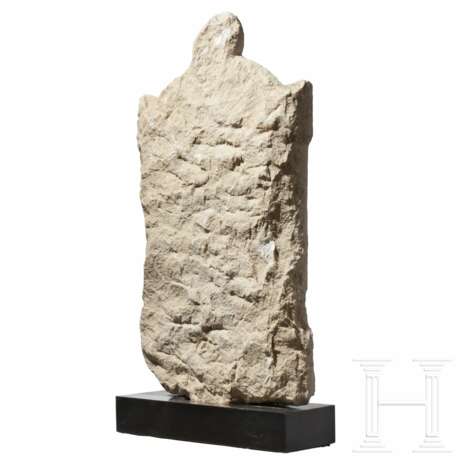ID 1198566
Lot 43 | Grabstele eines Venators aus Marmor, römisch, 3. Jhdt. n. Chr.
Abgesehen von minimalen Absplitterungen vollständig erhaltener Grabstein eines bewaffneten Mannes. Weißer Marmor, mit bräunlichem Sinter bedeckt. Tracht, Frisur und Stil sprechen für eine Herkunft aus den Provinzen des kleinasiatischen Mittelmeerraumes. Seitliche Pilaster mit Wellenranke, darüber ein Bogen mit Palmetten an den Seiten und über der Mitte, bilden eine Aedicula, in der die dargestellte Person frontal steht. Darunter die griechische Grabinschrift "Menophilos dem Andenken an seinen allerliebsten Bruder Trophimos". Der Mann mit fülligem gelockten Haar trägt eine Tunika mit zahlreichen, streifenförmigen Textilappliken, oberhalb des rechten Knies ein schwer zu deutendes Stück drapierten Stoffes. In der Rechten eine kurze Lanze mit Widerhaken an der Spitze. Über der Schulter ein Balteus (Schwertgurt) mit typischen Beschlägen (Phalera und Riemenzunge), an dem ein Schwert hängt. Dahinter sichtbar wohl ein kleiner Rundschild mit herabhängenden Zierstreifen. In der Linken ein weiteres Schwert. Das Schuhwerk relativ undifferenziert und ohne Details dargestellt. Wenngleich die Ausrüstung militärische Elemente enthält, erlaubt sie nicht, im Dargestellten einen Soldaten zu erkennen. Die Frisur ist unmilitärisch. Die Kleidung entspricht nicht dem bekannten Schema bei Militärs und scheint eher übermäßig prachtvoll, wohl bunt verziert gewesen zu sein. Unter anderem fehlt der typische Soldatenmantel (Sagum) und ein den Soldaten kennzeichnender Gürtel. Ähnliches gilt für die Ausrüstung mit viel zu kurzer Lanze und ungewöhnlicher Waffenkombination. Andererseits wusste der Bildhauer Details der Ausrüstung, die dem militärischen Bereich entlehnt sind, wie den Schwertgurt, präzise darzustellen. Dennoch handelt es sich offensichtlich nicht um einen Soldaten. Eine Lösung dieser Deutungsschwierigkeiten könnte die Interpretation der Figur als "venator" sein, ein professioneller Jäger, der bei Tierhatzen in der Arena auftrat. Für diesen Berufsstand sind Ausrüstung und Auftreten dieser Art überliefert und denkbar; unter anderem die Lanze mit Widerhaken sowie die pittoreske Natur von Frisur und Gewand. Die Angleichung an die Tracht zeitgleicher Militärs des 3. Jhdts. stellte wohl den Versuch dar, dem gesellschaftlich eher ambivalenten Status der Profis aus öffentlichen Spielen in der Arena, der zwischen Starkult und Verachtung schwankte, etwas vom Prestige der als gesellschaftlich voll etablierten und hoch angesehenen Soldaten zu verleihen. Höhe ohne Sockel 81 cm, Breite 46 cm, Tiefe 6 cm. Gewicht mit Sockel 49,5 kg. Beiliegend ein Auszug aus dem Art Loss Register sowie ein Gutachten in englischer Sprache von J.C.N. Coulston, einem führenden Spezialisten für römisches Militärwesen aus England.
Provenienz: Englische Privatsammlung, übernommen aus der Sammlung des Vaters, von diesem 1968 im Londoner Kunstmarkt erworben.
A Roman marble gravestone of a venator, 3rd century A.D.
A Roman marble gravestone of a venator, 3rd century A.D.
Apart from minimal spalling the gravestone of a man-at-arms completely preserved, in white marble, covered in brownish sinter. His dress, hair and style suggest that it originates from the provinces of the Mediterranean region of Asia Minor. The lateral pilasters with an undulating tendril, above which an arch with palm trees at the sides und centre top, forming an aedicula, in which the portrayed figure stands at the front. At the base the epitaph "(tr). Menophilos in memory of his most dearly beloved brother Trophimos" inscribed in Greek. His hair falling in abundant curls, the man wears a tunic with numerous appliquéd strips of material, a length of cloth draped above his right knee that is difficult to interpret. A short lance with barbed point in his right hand. A balteus (sword belt) draped over his shoulder, with characteristic fittings (phalera and tongue piece), from which a sword is suspended. Behind which a small, presumably circular, shield can be seen with pendent linear ornaments. His left hand holding a second sword. His footwear sculpted without definition or intricate detail. Although his attire includes military elements, it does not signify clearly that the man was a soldier. His hairstyle is non-military. His garments are not consistent with traditional military dress, appearing excessively sumptuous, probably with colourful embellishments. Inter alia, he wears neither a typical soldier's cloak (sagum) nor a soldier's belt. The same applies to his weaponry; his lance is far too short and he bears an unusual combination of arms. On the other hand, the sculptor was able to portray certain details of his attire that have a military aspect, like the sword belt, with great accuracy. Nevertheless, the man is obviously not a soldier. One solution to the difficulty of interpreting the figure is that he may have been a "venator", a professional hunter who took part in spectacles in the arena involving animal fights. As the weaponry and attire of these professional fighters have been recorded, this is conceivable, especially the lance with the barbed point and the picturesque appearance of his hairstyle and dress. The fact that his dress is adapted to that of contemporary, 3rd century soldiers presumably represents an attempt to lend the professional fighter, who took part in public spectacles in the arena and whose social status was relatively ambivalent, varying from stardom to contempt, some of the social prestige of the fully established, highly respected soldier. Height without pedestal 81 cm, width 46 cm, depth 6 cm. Weight including pedestal 49.5 kg. Includes an extract from the Art Loss Register and an English-language expertise prepared by J.C.N. Coulston, a leading specialist for Roman Army studies in England.
Provenance: English private collection, acquired by the seller's father in 1968 on the art market in London and inherited from the collection.
Condition: II +
| Place of origin: | Roman Empire |
|---|
| Place of origin: | Roman Empire |
|---|
| Address of auction |
Hermann Historica Bretonischer Ring 3 85630 Grasbrunn / München Germany | ||||||||||||||
|---|---|---|---|---|---|---|---|---|---|---|---|---|---|---|---|
| Preview | |||||||||||||||
| Phone | +49 (0)89 5472 649 0 | ||||||||||||||
| Fax | +49 (0)89 5472 64999 | ||||||||||||||
| Buyer Premium | 25 % | ||||||||||||||
| Conditions of purchase | Conditions of purchase | ||||||||||||||
| Business hours | Business hours
|



